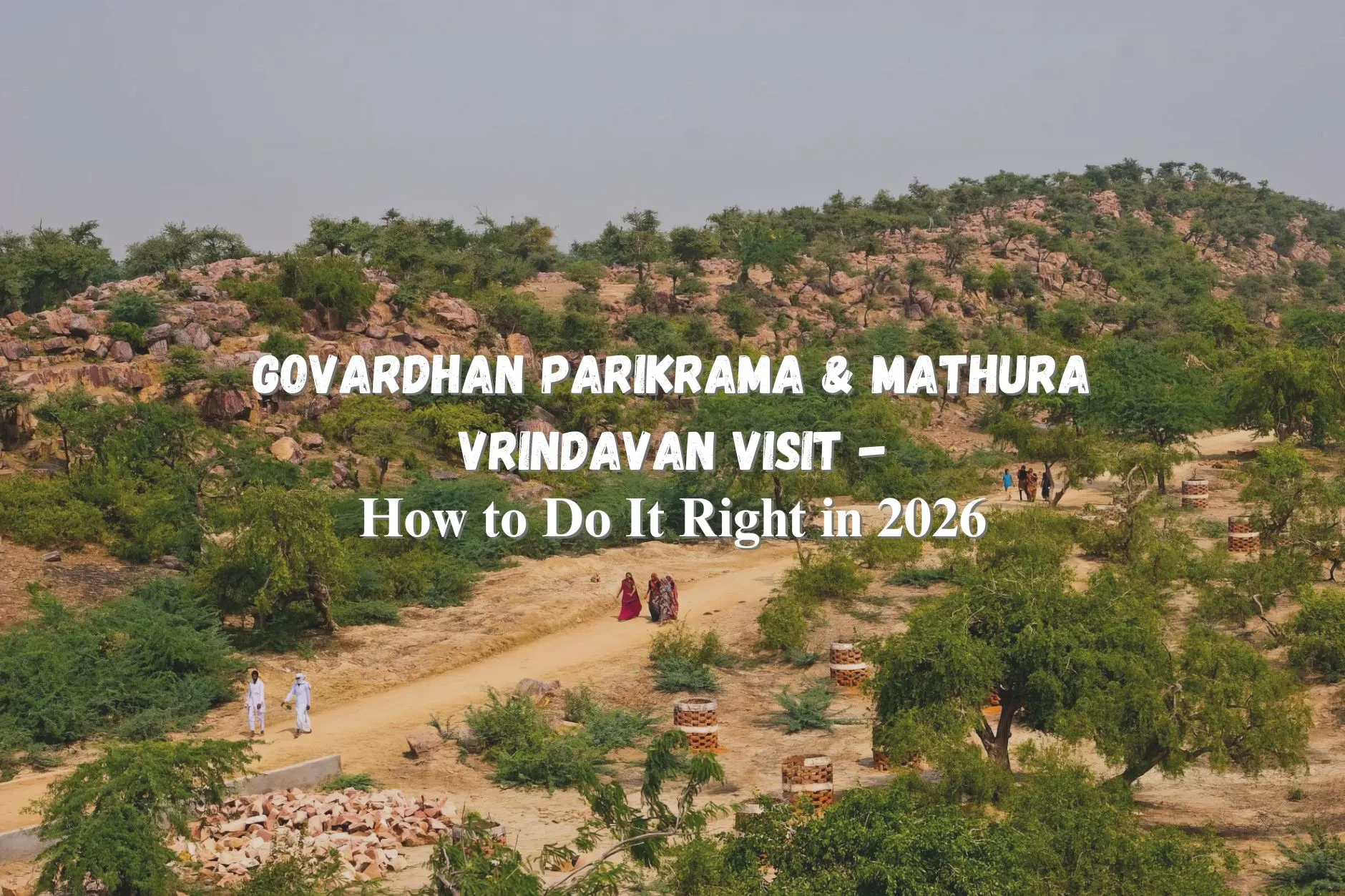Govardhan, the sacred hill located in Mathura, holds unparalleled spiritual significance in the life and teachings of Lord Krishna.
For any devotee planning a Mathura Vrindavan tour package, including Govardhan is not merely an option—it is a sacred obligation that every devotee must fulfill at least once in their lifetime.
This comprehensive guide explores the profound reasons behind this visit, detailing Govardhan parikrama, Govardhan hill temples, Krishna Govardhan leela sites, Mathura Govardhan pilgrimage spots, best time for Govardhan parikrama, and a complete Govardhan temple list.
Situated just 22 km from Mathura and 13 km from Vrindavan, Govardhan forms the essential third pillar of the Braj Yatra: Mathura represents Krishna’s birth, Vrindavan his youthful ras leelas, and Govardhan his divine protection of devotees.
The 21-km Govardhan parikrama path encircles the Govardhan hill, passing through 24 sacred kusums (points) that mark specific Krishna leela sites.
Each step along this path connects devotees directly to the Bhagavata Purana’s account of Krishna lifting the entire hill on his little finger for seven days to shield the residents of Gokul and Vrindavan from Indra’s torrential rains.
This act symbolizes the triumph of bhakti over ego, nature worship over ritualistic dharma, and complete surrender to the divine.
To ensure a seamless and comfortable experience during your Mathura Govardhan pilgrimage, Mathura Taxi Service offers specialized transportation solutions tailored for Govardhan tours within Mathura Vrindavan tour packages.
Our fleet of air-conditioned vehicles, experienced drivers familiar with all 24 kusums, and customized itineraries eliminate travel hassles.
Contact Mathura Taxi Service at mathurataxiservice@gmail.com, +91 9634616363, or visit mathurataxiservice.com to book your Govardhan parikrama package.
They provide door-to-door service from Mathura hotels, midway pickups during the walk, cold water provisions, and safe return to Vrindavan, making the journey accessible for families, senior citizens, women, and first-time pilgrims.
The Profound Spiritual Importance of Govardhan for Every Devotee
The Govardhan leela forms the cornerstone of Krishna’s teachings on surrender and protection. As narrated in the Bhagavata Purana (10th Canto, Chapter 24-25), the young Krishna convinced the gopas and gopis to worship Govardhan Hill instead of Indra, angering the rain god who unleashed catastrophic storms.
In response, Krishna effortlessly lifted the 80-foot sandstone hill with his pinky finger, creating a natural umbrella that sheltered all for seven days and nights. This miracle established Govardhan as Giriraj Ji—a living deity worthy of worship.
For devotees, visiting Govardhan fulfills multiple scriptural injunctions:
- Puranic Merit: The Skanda Purana states that one Govardhan parikrama equals bathing in all 60,000 holy rivers of India.
- Karmic Purification: Touching Giriraj Ji erases accumulated sins from countless births.
- Lifelong Protection: Krishna’s promise in Bhagavad Gita 9.29—”I am equally disposed to all… but those who worship Me with devotion are in Me, and I am in them”—manifests directly at Govardhan.
- Moksha Guarantee: Padma Purana declares that sincere darshan here leads to liberation from the cycle of birth and death.
Best Time for Govardhan Parikrama: The auspicious Kartik month (October-November), especially during Govardhan Puja on the day after Diwali. Lakhs of devotees converge, filling the air with continuous kirtans, floral decorations, and massive annadhan feasts. The parikrama path becomes a river of faith, with brass bands, dancing pilgrims, and free satvik meals at every kusum. Off-season visits (September-March) offer solitude for deep meditation, ideal for personal sankalps.
Why Once in a Lifetime? Vaishnava acharyas like Vallabhacharya and Chaitanya Mahaprabhu emphasize that one sincere Govardhan visit fulfills this darshan for all future janmas. Neglecting it deprives the soul of Krishna’s direct shelter. In your Mathura Vrindavan tour package, allocate a full day: depart Mathura at 3:30 AM, complete parikrama by 2 PM, and return refreshed.
Mathura Taxi Service enhances this experience with packages including early morning pickups, taxi-assisted parikrama (walking only desired segments), and temple entry coordination, ensuring you cover all Krishna Govardhan leela sites without fatigue.
Table: Complete Govardhan Temple List
| Place Name | Significance & Leela | Best Time | Detailed Tips (Duration) |
|---|---|---|---|
| Radha Kund | Love fulfillment (Arishtasur slaying) | Kartik Purnima | Dip + tulsi (45 min) |
| Govardhan Hill | Protection miracle | 4 AM | Tilak + chants (30 min) |
| Manasi Ganga | Mind purification | Sunrise | Fish feeding (40 min) |
| Mukharvind | Flute devotion | 6 PM | Cave meditation (50 min) |
| Jatira Van | Cow protection | Midday | Dust rolling (35 min) |
| Charan Pahari | Footprint darshan | Anytime | Forehead touch (20 min) |
| Gopal Ji Temple | Pushtimarg sevas | 8 PM Aarti | Sila collection (1 hr) |
| Annakshetra | Annadhan feast | 1 PM | Communal meal (45 min) |
| Uchhal Kund | Family harmony | 3 PM | Water sprinkle (25 min) |
| Govinda Kund | Ego victory bath | Sunset | 7 dips (40 min) |
| Kusum Sarovar | Meditation grove | Morning | Tree offerings (30 min) |
| Baladev Temple | Brotherly support | Noon | Sugarcane offering (25 min) |
Top 12 Places to Visit in Govardhan: Complete Govardhan Temple List
The parikrama path features 24 kusums, but these 12 essential Govardhan hill temples and Krishna leela sites form the core itinerary. Each includes detailed significance, visiting protocols, and scriptural quotes.
1. Radha Kund: Supreme Pond of Divine Love
Krishna personally dug this kund using his sudarshan chakra after slaying the demon Arishtasur, then bathed here with Radha.
Significance: Highest merit among all tirthas; fulfills marital and spiritual desires; destroys 100 lifetimes of sins.
Best Time: Kartik Purnima (full moon).
Detailed Tips: Separate bathing ghats for men/women; offer 108 tulsi leaves; circumambulate clockwise; collect sacred water in small bottle. Duration: 45 minutes.
“One who bathes in Radha Kund attains Radha’s eternal service.” – Padma Purana.
2. Govardhan Hill (Giriraj Ji): The Lifted Deity
The actual 80-foot red sandstone hill, worshipped with 24 daily aartis like a temple deity.
Significance: Direct embodiment of Krishna’s protective power; touching the base grants victory over obstacles.
Best Time: Brahma Muhurta (4 AM).
Detailed Tips: Perform tilak with Govardhan mud; chant “Giriraj Ji Ki Jai” 108 times using mala; receive sila prasadam from priests. Duration: 30 minutes.
“I lifted Govardhan with my little finger to protect my devotees from Indra’s wrath.” – Bhagavata Purana 10.25.20.
3. Manasi Ganga Kund: Krishna’s Miraculous Lake
Created when Krishna hurled his discus to form a Yamuna-like lake for the gopis’ convenience post-ras leela.
Significance: Purifies the mind of all doubts; ideal starting point for sankalps.
Best Time: Sunrise.
Detailed Tips: Feed multicolored fish with puffed rice; perform 11 circumambulations; immerse personal items for blessings. Duration: 40 minutes.
“Abandon all varieties of religion and just surrender unto Me.” – Bhagavad Gita 18.66.
4. Mukharvind: Flute Valley of Divine Call
Natural cave complex where Krishna played his bansuri, compelling 10,000 gopis to abandon household duties.
Significance: Awakens dormant bhakti; cures hearing-related ailments.
Best Time: Evening (6 PM).
Detailed Tips: Sit in lotus position inside caves; listen to live flute recitals; offer yellow flowers. Duration: 50 minutes.
“The sound of my flute pierces the hearts of pure devotees.” – Gita Govinda 1.14.
5. Jatira Van: Sacred Forest of Cow Protection
Dense grove where Krishna neutralized Kalya Nag’s poison, saving 900,000 cows.
Significance: Grants wealth, health, and progeny; rolling in dust equals 12 years of penance.
Best Time: Midday (11 AM-2 PM).
Detailed Tips: Remove shoes; roll thrice clockwise; offer fresh grass bundles (₹20 from vendors). Duration: 35 minutes.
“Bhakti provides shelter more secure than Govardhan itself.” – Vishnu Purana.
6. Charan Pahari: Hill of Divine Footprints
Small hillock preserving Krishna’s actual foot imprints from the lifting leela.
Significance: Grants safe travels and obstacle-free life paths.
Best Time: Anytime.
Detailed Tips: Wash footprints with Ganga water; place forehead on each print; photograph respectfully. Duration: 20 minutes.
“Those who follow in My footsteps never stumble.” – Bhagavad Gita 4.11.
7. Gopal Ji Temple: Ancient Pushtimarg Shrine
17th-century temple housing Vallabhacharya’s personal Krishna deity, brought from Gujarat.
Significance: Center for sevas and discourses; sila worship begins here.
Best Time: Shringar Aarti (8 PM).
Detailed Tips: Attend 5 daily aartis; receive personalized sila; donate for temple maintenance. Duration: 1 hour.
“Whoever offers me a leaf, flower, fruit, or water with love—I accept.” – Bhagavad Gita 9.26.
8. Annakshetra: Global Annadhan Center
Vast complex serving 50,000+ free meals daily, commemorating the leela’s communal feast.
Significance: Fulfills both stomach and soul; equals feeding Krishna directly.
Best Time: Post-parikrama (1 PM).
Detailed Tips: Eat on floor with hands; serve others first; donate grains if possible. Duration: 45 minutes.
“Food offered to Me becomes nectar for devotees.” – Bhagavad Gita 9.27.
9. Uchhal Kund: Pond of Marital Harmony
Where Krishna playfully hid gopis from jealous wives, teaching forgiveness.
Significance: Resolves family conflicts; blesses childless couples.
Best Time: Afternoon (3 PM).
Detailed Tips: Sprinkle water on head while naming family members; tie red threads on trees. Duration: 25 minutes.
“In My divine pastimes, even jealousy becomes a path to devotion.” – Bhagavata Purana 10.22.
10. Govinda Kund: Victory Bathing Ghat
Site of Krishna’s post-lifting bath, symbolizing triumph over ego.
Significance: Heals chronic diseases; instills unshakeable confidence.
Best Time: Sunset.
Detailed Tips: 7 dips facing east; chant victory mantras; collect pebbles as talismans. Duration: 40 minutes.
“The humble soul conquers the universe.” – Bhagavad Gita 13.8-12.
11. Kusum Sarovar: Grove of 12 Sacred Trees
Ancient banyan grove where Krishna rested during the lifting, surrounded by 12 flower-filled kunds.
Significance: Enhances meditation; grants 12 types of siddhis.
Best Time: Morning.
Detailed Tips: Offer flowers at each tree; sit under central banyan for 15 minutes. Duration: 30 minutes.
“Meditate upon Me under sacred trees.” – Bhagavad Gita 6.13-14.
12. Baladev Temple: Brotherly Protection Shrine
Temple honoring Balram, who guarded the hill’s base during the leela.
Significance: Provides sibling harmony and agricultural prosperity.
Best Time: Noon.
Detailed Tips: Offer sugarcane; perform joint Krishna-Balram aarti. Duration: 25 minutes.
“My brother Baladev supported the hill’s weight with me.” – Harivamsa Purana.
Complete Step-by-Step Govardhan Parikrama Guide
- Preparation (3 AM): Mathura Taxi pickup; light breakfast; wear cotton clothes.
- Start (4 AM): Manasi Ganga – sankalp + first dip.
- 0-5 km: Manasi Ganga → Radha Kund → Giriraj Base (walking/taxi mix).
- 5-10 km: Mukharvind → Jatira Van → Charan Pahari.
- 10-15 km: Gopal Temple → Annakshetra lunch → Kusum Sarovar.
- 15-21 km: Uchhal Kund → Govinda Kund → Baladev Temple → Return.
- Completion (1-2 PM): Final aarti at Manasi Ganga; taxi return. Total Duration: 6-8 hours. Distance Breakdown: 12 km walking + 9 km taxi. Essentials: 3L water, energy bars, medical kit, charged phone, prasadam bag.
12 Compelling Reasons Every Devotee Must Visit Govardhan Once
- Immense Punya: Equals 84 Kos Braj parikrama merit.
- Obstacle Destruction: Krishna’s guaranteed protection (Gita 9.29).
- Bhakti Amplification: Direct leela site connection.
- Physical Detox: 21 km walk purifies 7 chakras.
- Family Unification: Shared pilgrimage strengthens bonds.
- Festival Ecstasy: Govardhan Puja’s divine vibrations.
- Moksha Assurance: Skanda Purana’s liberation promise.
- Sila Protection: Home worship wards negativity forever.
- Mental Tranquility: Natural serenity heals anxiety.
- Progeny Blessings: Radha Kund fulfills family wishes.
- Health Restoration: Jatira dust cures chronic ailments.
- Eternal Remembrance: One visit remembered across lifetimes.
“The devotee who performs Govardhan parikrama with pure heart attains My eternal abode.” – Skanda Purana.
Seamless Travel with Mathura Taxi Service
Mathura Taxi Service excels in Govardhan logistics:
- Fleet: Innova/Ertiga AC vehicles (6-8 seater).
- Coverage: All 24 kusums + midway rests.
- Add-ons: Guide, water, snacks, medical kit.
- Timings: 24/7, festival specials.
- Pricing: Transparent, no hidden fees.
Book now: mathurataxiservice@gmail.com | +91 9634616363 | mathurataxiservice.com.
Conclusion: Embrace Krishna’s Eternal Shelter at Govardhan
Every devotee must visit Govardhan once in a lifetime to receive Krishna’s unbreakable protection and complete the Braj Yatra. These Krishna Govardhan leela sites transform theoretical knowledge into living faith, fulfilling scriptures’ highest injunctions. Integrate Govardhan into your Mathura Vrindavan tour package today.
With Mathura Taxi Service handling all arrangements, immerse completely in bhakti. As Krishna promises: “To those who are constantly devoted… I give the understanding by which they can come to Me.” (Bhagavad Gita 10.10). Your Govardhan journey awaits—begin the parikrama of eternal grace.
FAQs
1. Why is Govardhan Hill so sacred in Hinduism?
Govardhan Hill is considered an embodiment of Lord Krishna himself. According to Hindu scriptures, Krishna lifted the hill on his little finger to protect the villagers of Braj from Lord Indra’s wrath, symbolizing divine protection and surrender.
2. Where is Govardhan located?
Govardhan is situated about 25 km from Mathura and 22 km from Vrindavan in Uttar Pradesh. It’s a peaceful pilgrimage town surrounded by sacred ponds, temples, and ghats.
3. What is the significance of performing Govardhan Parikrama?
Performing the Govardhan Parikrama (circumambulation) is believed to wash away sins and bring spiritual fulfillment. The full parikrama is 21 km long, and devotees walk barefoot chanting Krishna’s name as an act of devotion and surrender.
4. How long does it take to complete Govardhan Parikrama?
It usually takes 5 to 6 hours for the full parikrama, depending on your pace. Many devotees also do the half parikrama (12 km) which covers the main holy points.
5. What are the main places to visit around Govardhan Hill?
Key spots include Mansi Ganga, Radha Kund, Kusum Sarovar, Govind Kund, Danghati Temple, and Mukharvind Temple, all deeply associated with the divine pastimes of Radha and Krishna.
6. When is the best time to visit Govardhan?
The best time is during Govardhan Puja (next day after Diwali), Guru Purnima, and Radhashtami. The weather from October to March is ideal for parikrama and temple visits.
7. What rituals do devotees perform at Govardhan?
Devotees offer Annakut (mountain of food) to Lord Krishna, perform Parikrama, light diyas around the hill, and visit Radha Kund for holy bathing. Many also offer milk and flowers at sacred spots during prayers.
8. Is it necessary to walk barefoot during Parikrama?
Yes, most devotees walk barefoot as a mark of humility and devotion. However, those who are elderly or have health issues may use comfortable footwear without disrespecting the tradition.
9. How can I reach Govardhan from Mathura or Vrindavan?
You can easily reach Govardhan by car, taxi, or e-rickshaw from Mathura or Vrindavan. The journey takes about 40–45 minutes, and local transport is readily available for temple circuits.
10. Why should every devotee visit Govardhan at least once in their lifetime?
Visiting Govardhan is believed to bring divine blessings of Lord Krishna and Radha Rani. It’s not just a pilgrimage but a journey of the heart — where devotees experience peace, surrender, and the eternal love of Braj Bhoomi.






Leave a Reply